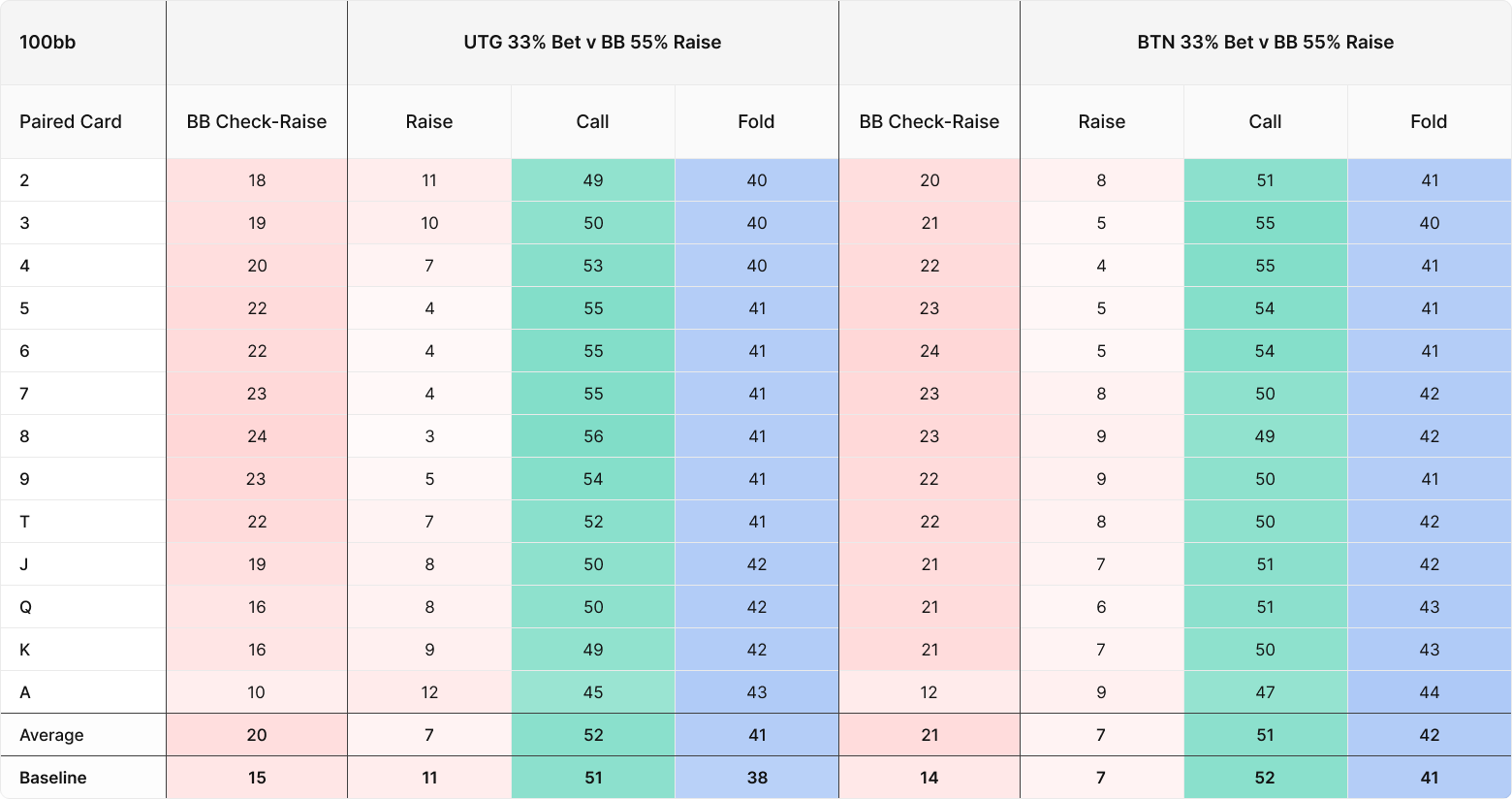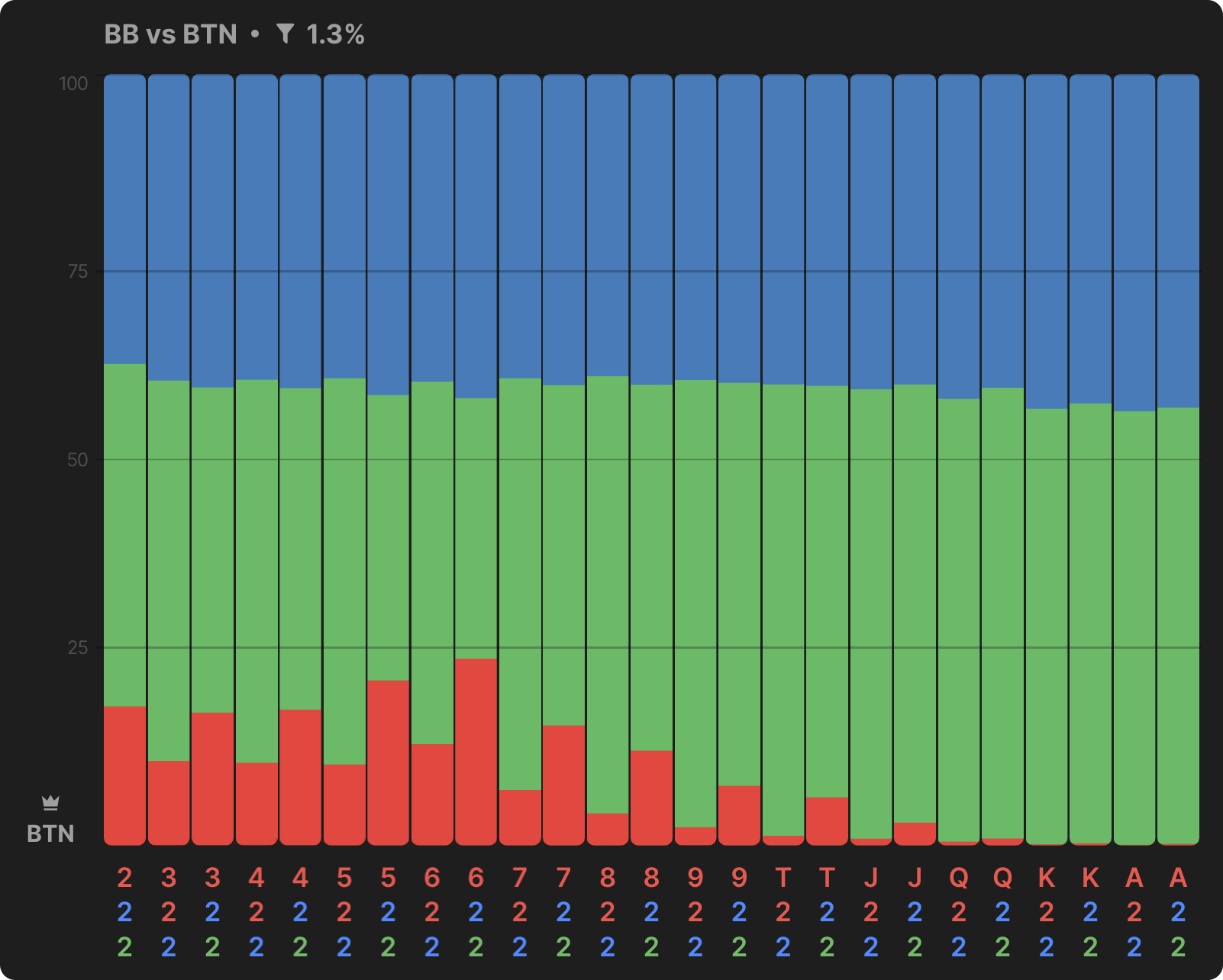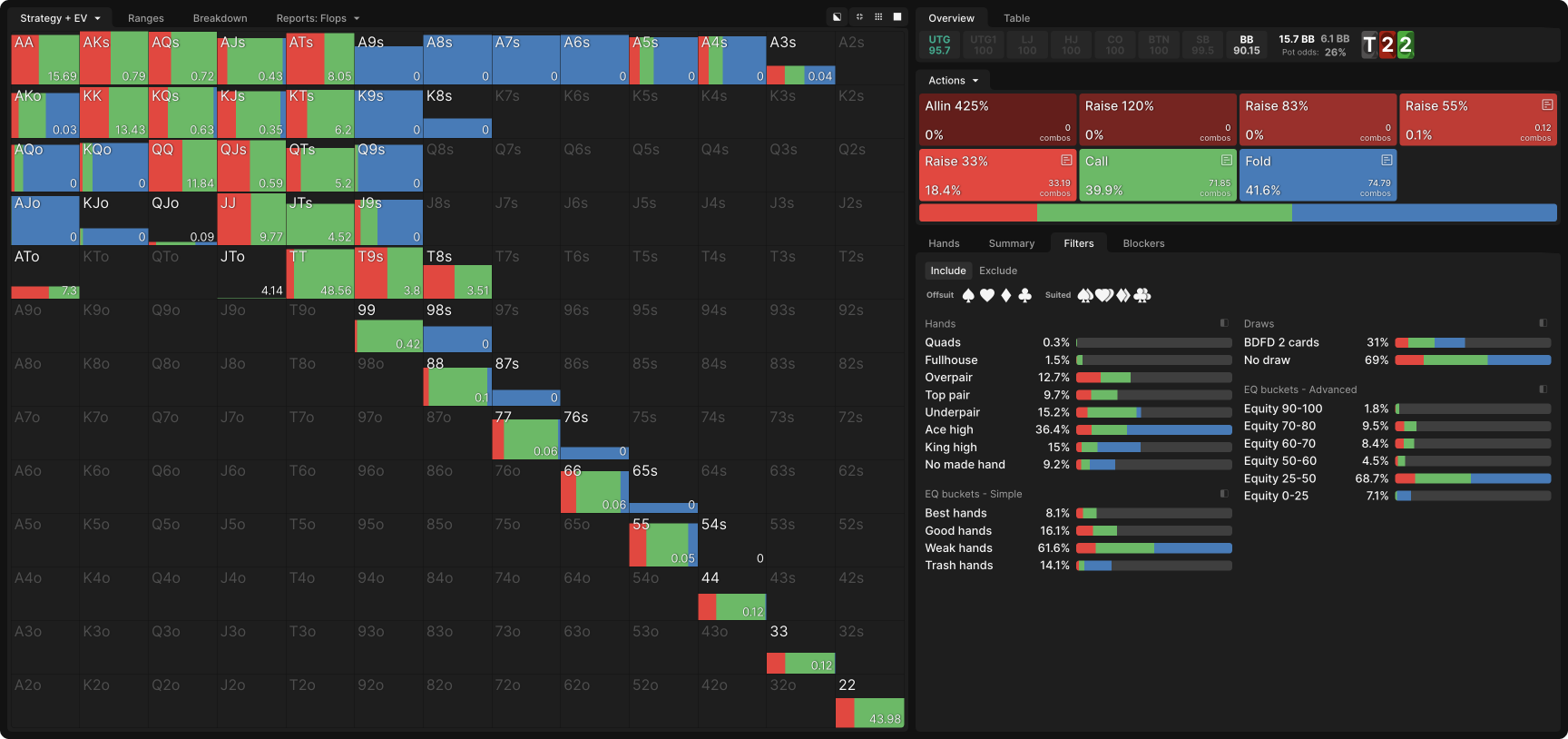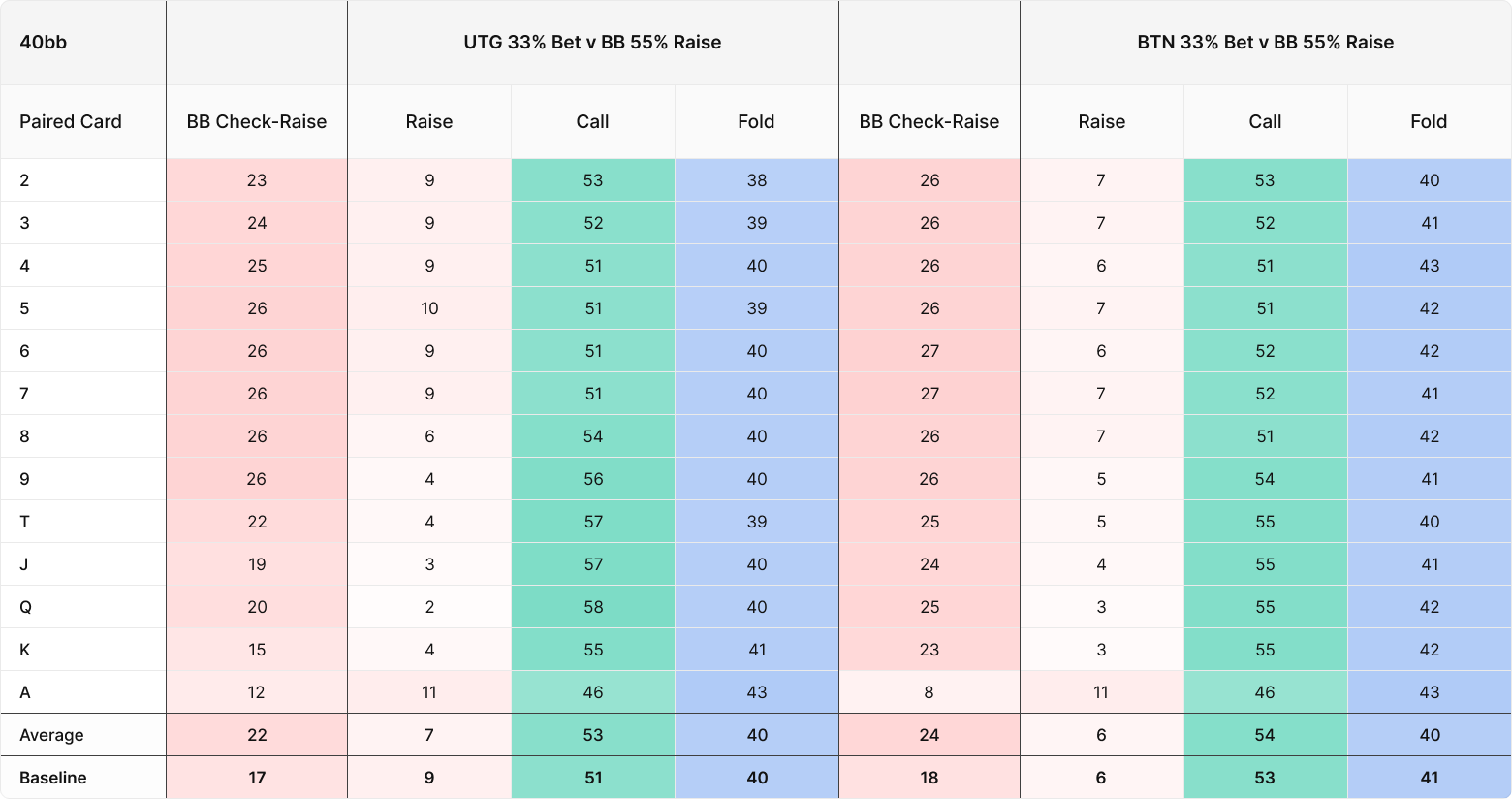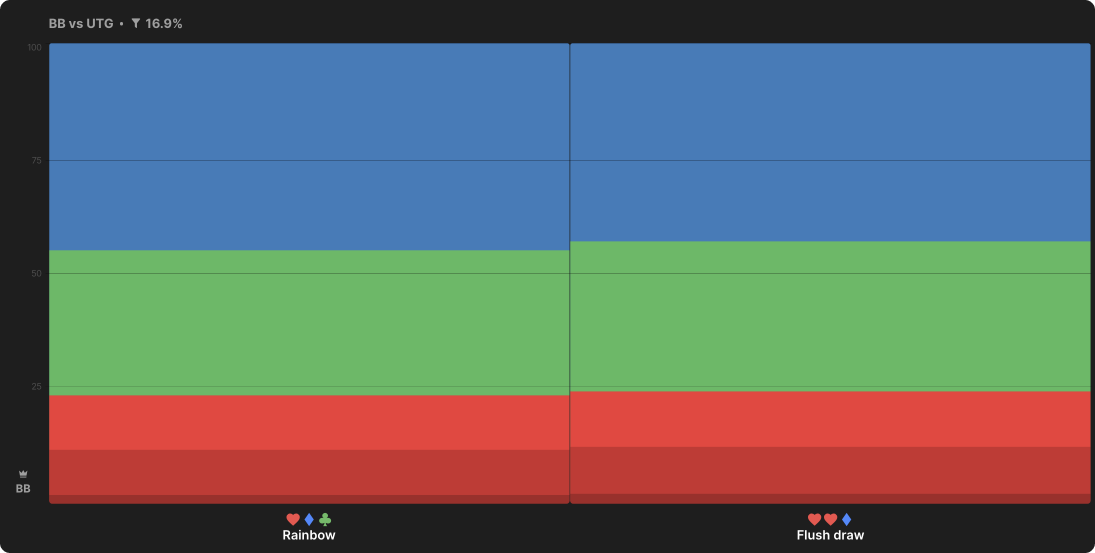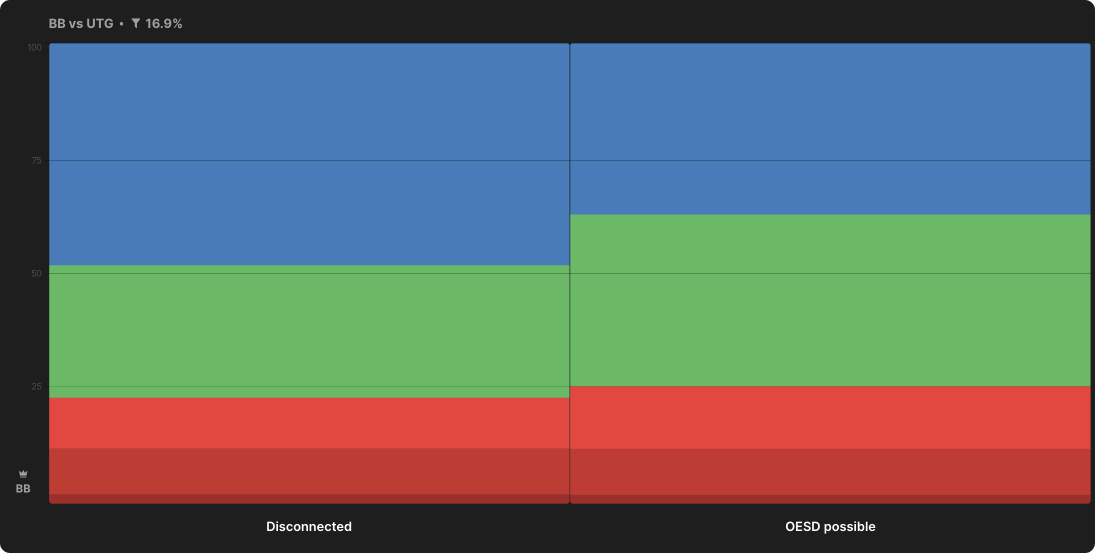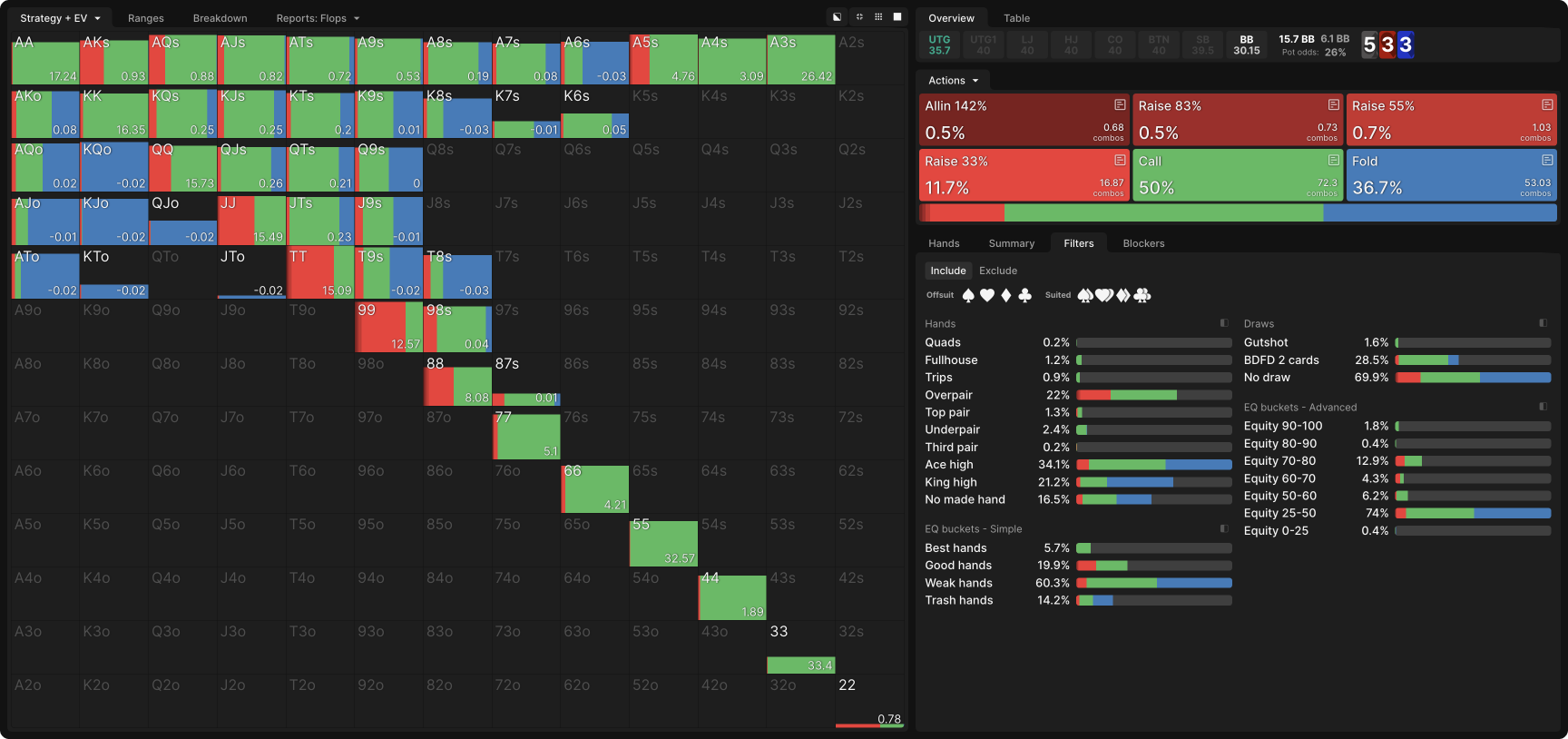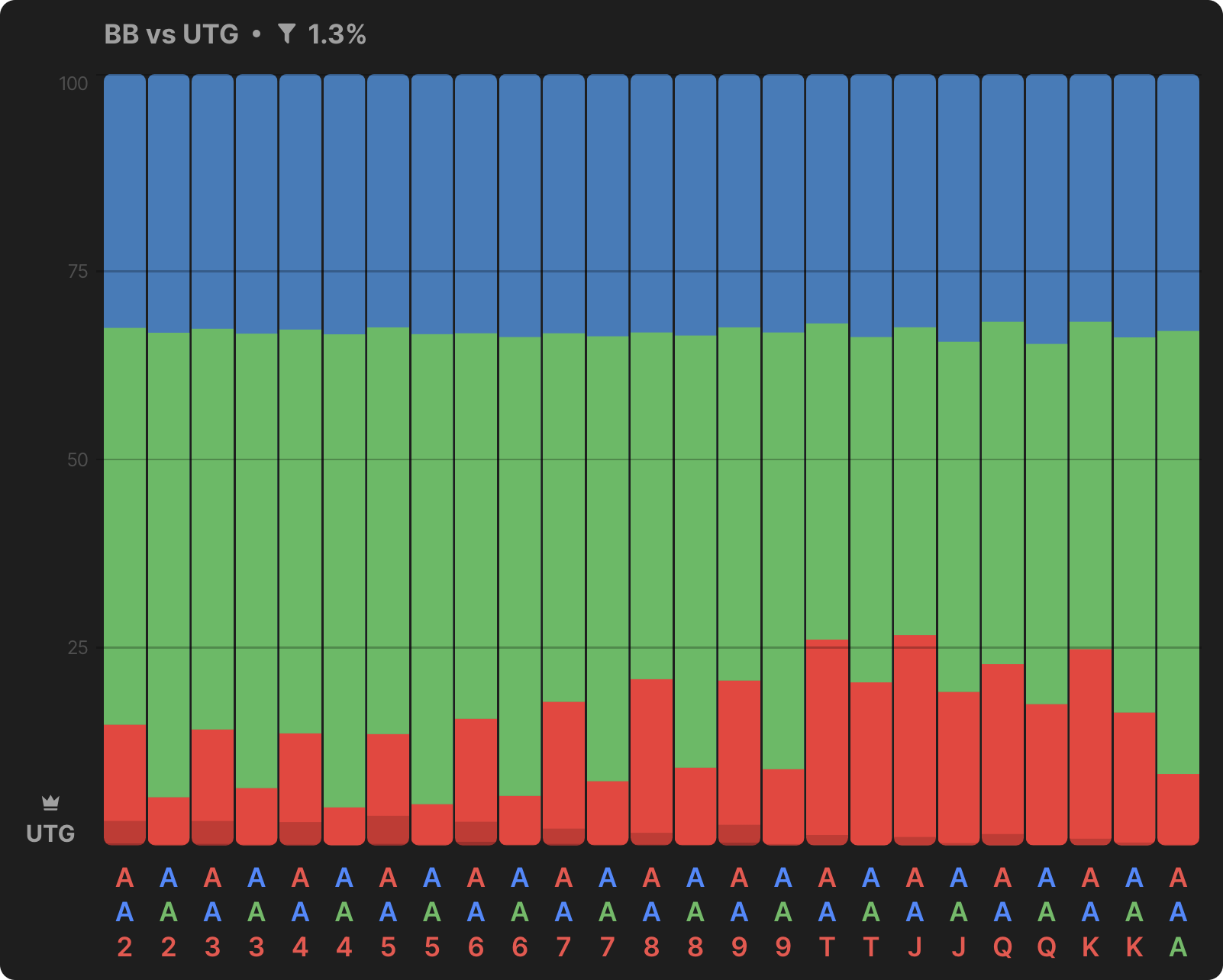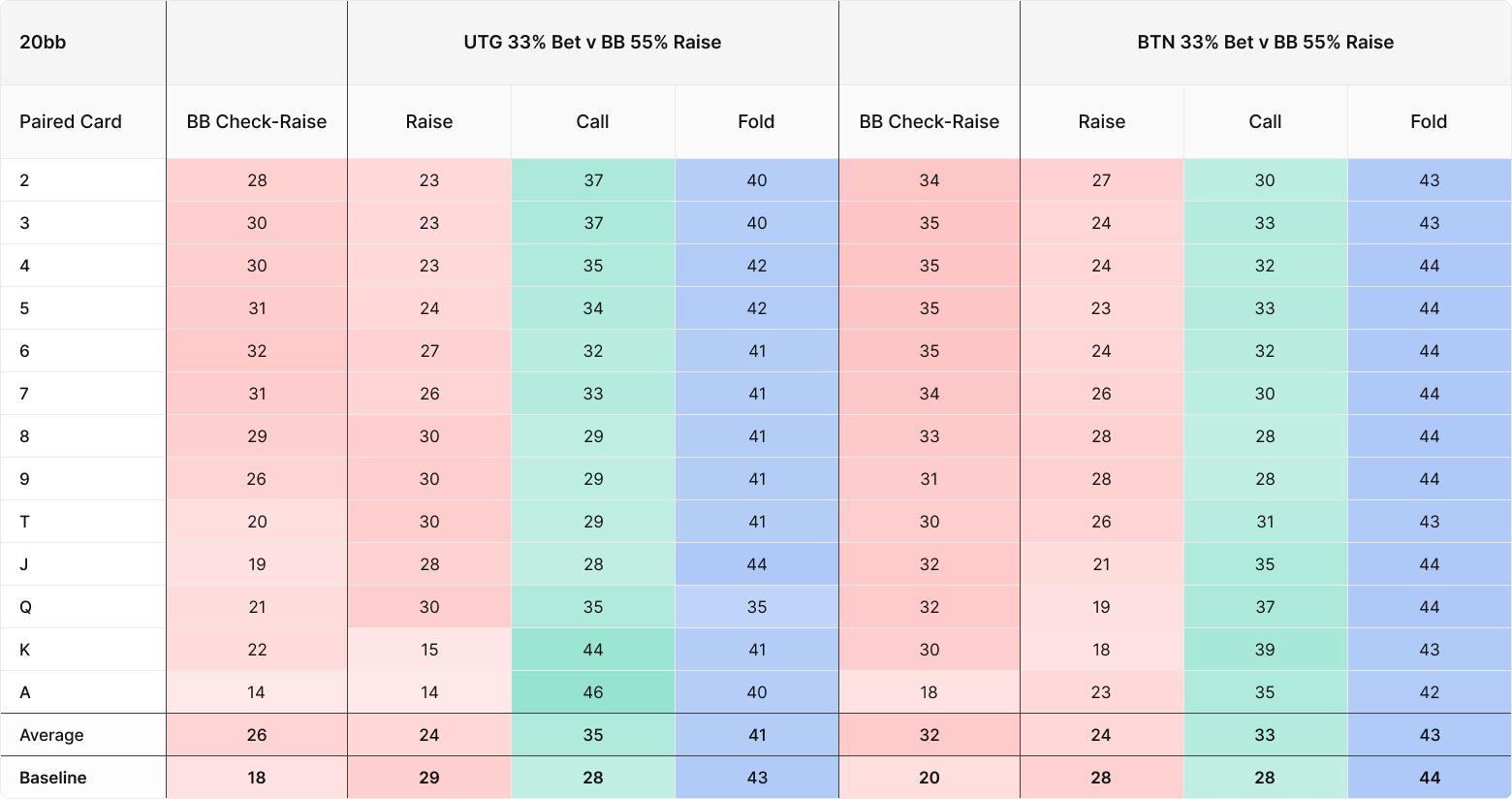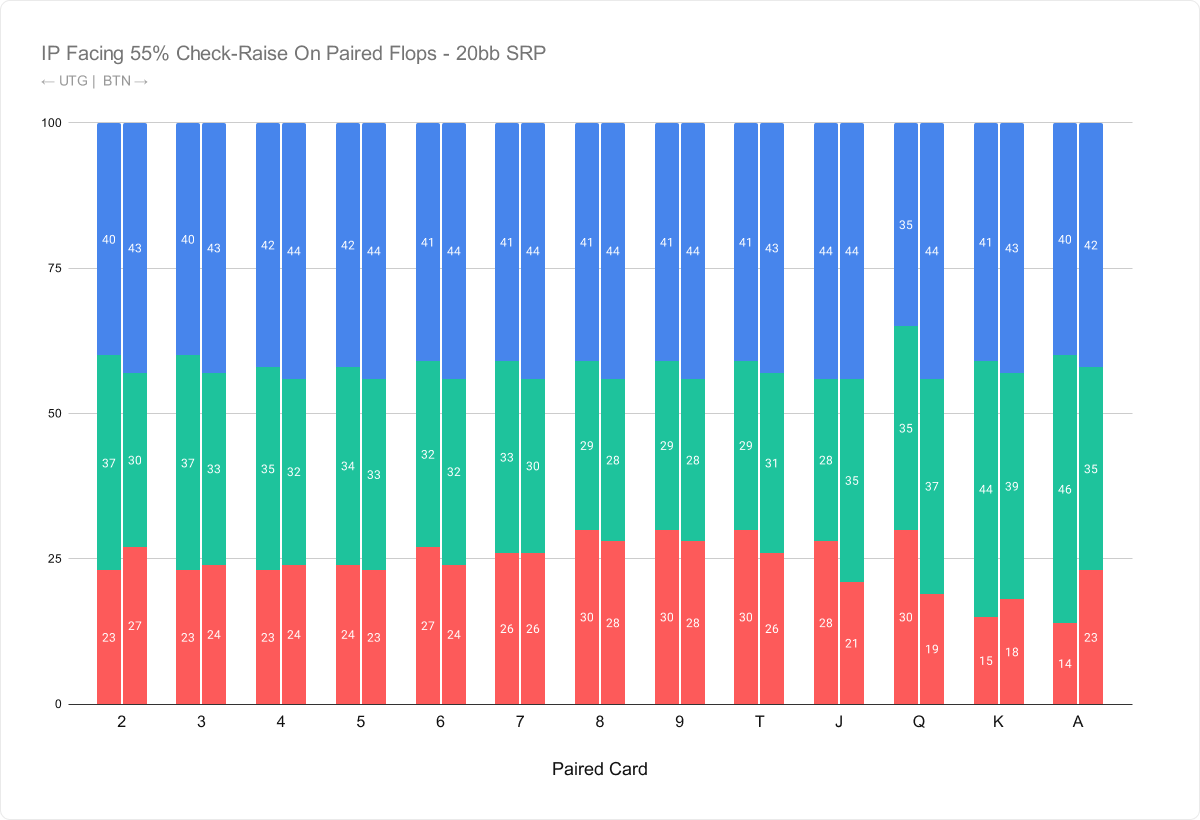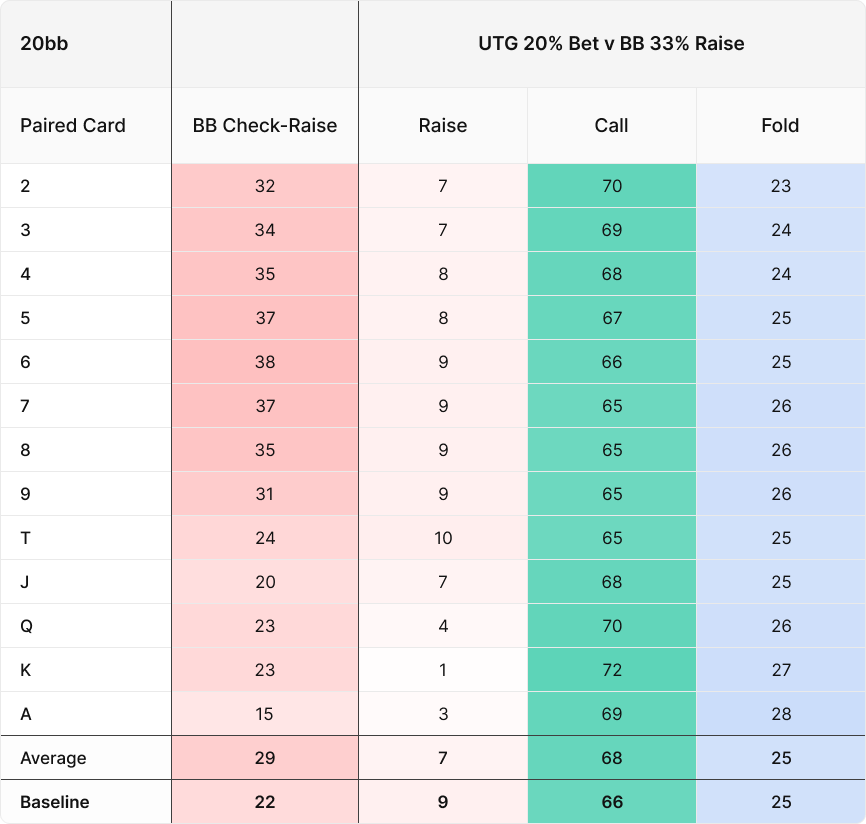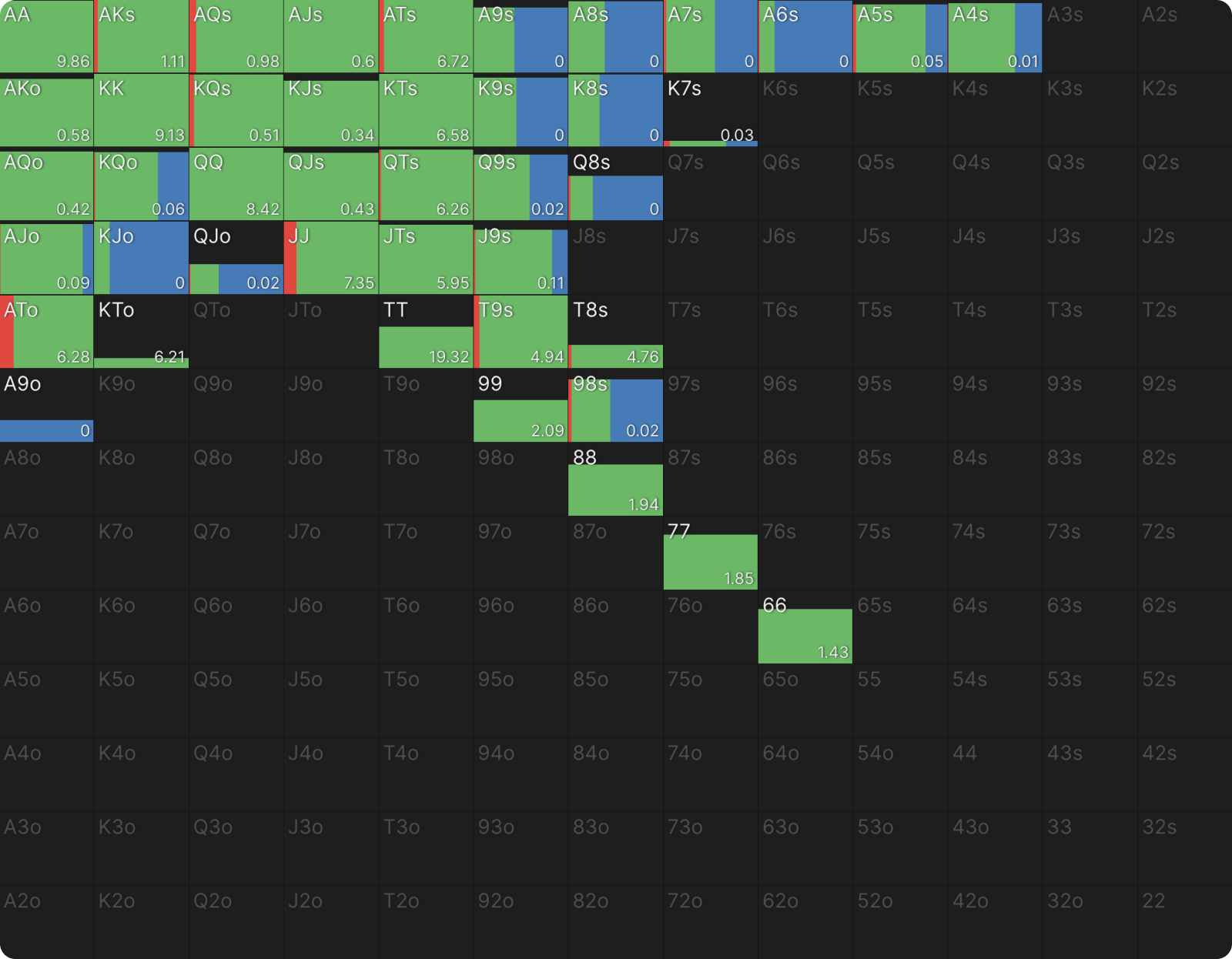Defending vs BB Check-Raise on Paired Flops

This is a companion piece to Attacking Paired Flops from the BB; you will get more out of it if you read that article first. In that article, we found that BB’s optimal response to a small continuation bet on paired flops involves a lot of check-raising, even more so than on the average flop. In this article, we will examine how the original raiser should respond to those raises.
The BB’s check-raise presents difficult decisions not only about whether to fold but also about whether to raise.
A well-constructed check-raising range will balance bluffs and value raises at a frequency that forces the bettor to continue not only with “obvious” hands such as pairs and draws but also with many hands that lack such coordination with the flop. In many cases, a balanced raising range also entails a polarized mix of nutty hands and weak bluffs, against which the bettor would prefer to call, and a linear mix of higher equity semi-bluffs and thin value bets, against which the bettor would prefer to three-bet. Thus, the BB’s check-raise presents difficult decisions not only about whether to fold but also about whether to raise.
A Note on Continuation Betting
One way to deal with tough decisions is to avoid them. If you don’t bet the flop, the BB can’t check-raise you. This is appealing logic, but it’s important to keep in mind that even though BB should check-raise paired flops aggressively, raising is still their least likely response in most situations. Fear of a raise should not deter you from realizing the many benefits of continuation betting against a BB caller. It is generally better to bet and then deal with the raise if it comes. This article will give you the tools to do just that.

One way to deal with tough decisions is to avoid them. If you don’t bet the flop, the BB can’t check-raise you. This is appealing logic, but it’s important to keep in mind that even though BB should check-raise paired flops aggressively, raising is still their least likely response in most situations. Fear of a raise should not deter you from realizing the many benefits of continuation betting against a BB caller. It is generally better to bet and then deal with the raise if it comes. This article will give you the tools to do just that.
Fear of a raise should not deter you from realizing the many benefits of continuation betting against a BB caller.
That said, checking is an important part of the preflop raiser’s strategy on many paired flops, especially those where the BB is significantly more likely than them to flop trips. The hands that benefit most from checking are usually unpaired overcards, the ones that would face the toughest decisions when raised. You can learn more about continuation betting–and not continuation betting–against the BB in this article.
Deep Stacks
The following chart shows the preflop raiser’s response to a 55% pot check-raise vs a 33% pot continuation bet 100bb deep. For consistency of comparison, I used these sizes for all situations, but they are not always the sizes the solver would primarily use in a given situation. That does not invalidate the results–your opponents will not always use the same sizes a solver would, and GTO strategies are robust against all opposing strategies. Just know that you should raise and call somewhat more often against smaller raises and somewhat less often against larger ones.
Denying the BB profitable bluffs will sometimes require continuing when you have neither a pair nor a draw.
First, notice that on all boards, at all stack depths, the bettor’s folding frequency hovers right around 40%. This is the Minimum Defense Frequency. This result implies that many of the bettor’s calls and raises are not going to be comfortable or obvious. Continuing only when you have a good pair or draw would not consistently yield the exact MDF in all situations.
Denying the BB profitable bluffs will sometimes require continuing when you have neither a pair nor a draw. The times to do this may not be immediately intuitive, but as we will see, they are not arbitrary. By studying and better understanding paired boards, you can build this intuition and make better decisions over the felt.
Second, notice that the bettor calls far more often than they 3bet. This is generally true when facing check-raises, and it is especially true on paired boards. Trips will be a big part of most check-raising ranges on these boards, and those hands will not face tough decisions when raised.

Denying the BB profitable bluffs will sometimes require continuing when you have neither a pair nor a draw. The times to do this may not be immediately intuitive, but as we will see, they are not arbitrary. By studying and better understanding paired boards, you can build this intuition and make better decisions over the felt.
Second, notice that the bettor calls far more often than they 3bet. This is generally true when facing check-raises, and it is especially true on paired boards. Trips will be a big part of most check-raising ranges on these boards, and those hands will not face tough decisions when raised.
Even when you yourself have trips, there is little need to raise: the pot is already getting large, you have position, and your hand is extremely difficult to draw out on. If your opponent is bluffing, there is little risk in giving them rope to keep bluffing. If they subsequently check the turn, you will still have the option to keep growing the pot then.
Three-Betting
The more likely the preflop raiser is to hold trips, the more likely they are to three-bet.
It may look like raising (three-betting) is just a small part of the bettor’s response to check-raises in general, but what’s really happening is that they have a relatively wide raising range on some boards and a tiny or non-existent one or others. Here is UTG’s response to a 55% pot check-raise on all X22 flops:
BTN’s response looks similar, but with less raising on the higher cards:
On some flops, the bettor three-bets as much as 25% of their range. On others, they do not three-bet at all.
They three-bet most on rainbow flops with low cards. On these boards, most of BB’s moderate equity bluffs struggle to continue to a three-bet. On a T22r flop, for instance, most of BB’s lighter check-raises are overcards like KJ with a backdoor flush draw. Whether UTG is three-betting a bluff of their own or top pair for thin value and protection, they are happy to deny equity to these overcards.
On T22tt, BB has stronger semi-bluffs that cannot be pushed off their equity so easily. This makes bluffing harder for UTG and three-betting top pair less desirable, as they could even face a four-bet from a flush draw. UTG also does not want to three-bet their own flush draws, which have good equity against the bottom of BB’s raising range but poor equity against the top.
If the unpaired card on the flop were higher, UTG would have less incentive to three-bet their pairs because there would be fewer overcards to protect against. This is why they do no three-betting on K22r and A22r. These patterns persist no matter what the pair is on the flop. The more likely the preflop raiser is to hold trips, the more likely they are to three-bet.
Hitting MDF
If you overfold the flop for fear of turn bets your opponent has not yet made, you will be exploited by players who aggressively check-raise the flop and then give up if called.
As discussed above, the bettor, whether UTG or BTN or anywhere in between, must continue to a check-raise with many unpaired hands or risk giving their opponent profitable bluffs with any two cards. Overcards with backdoor draws are the ideal candidates on rainbow boards, as can be seen in the T22r simulation above. On two-tone boards, flush draws create a lot more natural continuing candidates, so while most good backdoor draws still continue, UTG folds some overcards that have no other coordination with the board.
Not so for later position raisers, who will have much wider ranges and so must continue with many more hands. BTN never folds two overcards on TT2r and even continues most hands with one overcard and multiple backdoors. In fact, they call most of their Ace- and King-high hands even without any backdoors.
These are not especially profitable calls at equilibrium and will fold to turn bets if they do not improve, but it’s important to keep in mind those turn bets are not necessarily coming. If you overfold the flop for fear of turn bets your opponent has not yet made, you will be exploited by players who aggressively check-raise the flop and then give up if called. Then again, you will successfully exploit players who rarely check-raise the flop, or who always follow through on the turn. As with any exploitable strategy, it is not necessarily a mistake, but it is something you should only pursue deliberately and if you are comfortable betting that you are more likely to exploit your opponent than vice versa.
Medium Stacks
Whether UTG or BTN, the preflop raiser’s response to a 55% pot check-raise at 40bb looks quite similar to their response at 100bb:
With 40bb effective stacks, both players are putting stacks in with medium pocket pairs.
The most notable difference is more three-betting when the flop contains a small pair and on AAx flops. The bettor now also has more incentive to three-bet boards where open-ended straight draws are possible. The following charts show BB’s response to a 20% c-bet on paired flops:
These are related phenomena. With 40bb effective stacks, both players are putting stacks in with medium pocket pairs, even in UTG vs BB confrontations, where ranges are strongest. You may not be thrilled about stacking off with these hands, but you have a lot of incentive to raise them, as they are quite vulnerable and there is a chance your opponent is actually raising a lower pair for protection. You may be rooting for a fold when you three-bet 88, but if your opponent does shove, there will be too much in the pot for you to fold what could still be the best hand.
Here is UTG’s three-betting range on 533r:
You can see that it’s heavy on thin value/protection–even AK and AQ fall in this category, as they will call if BB shoves (BB has a lot of medium pairs and a few dominated semi-bluffs in their own range, and AK/AQ block their most prevalent combos of trips). There are very few bluffs because even the strong hands UTG raises are not purely for value but benefit a good deal from fold equity.
This gets to why there is more three-betting on connected boards: hands like AK, AQ, and A5 are thrilled to push BB off 76, which is drawing quite live against them, and the medium pairs are happy enough to put in more money as significant favorites against 64s and 42s. These medium pairs may not feel like monsters, but on this flop, they are strong enough to play for stacks. They aren’t getting any stronger, though, and they benefit from protection, so both players are incentivized to play them aggressively and stack off if it comes to that.
Three-betting on AAx boards is also driven by charging and/or denying equity to draws. UTG does most of their three-betting on boards featuring flush draws or broadway straight draws:
In fact, GTO Wizard prefers smaller bet sizes on AAx flops, where both players have a lot of trips. The three-betting strategy remains similar, however. This is UTG’s response following a 33% pot continuation bet and 33% pot raise, with the usual caveat that smaller raises call for slightly more aggressive responses:
Shallow Stacks
With shallow stacks, both players play much more aggressively. Many more hands are strong enough to get all in, and protecting and denying equity is at a premium. The following chart shows UTG and BTN responses after a 33% pot continuation bet and 55% pot check-raise 20bb deep:
As discussed above, I kept the bet and raise sizes the same as in the previous charts for the sake of comparison. However, shallow stacks are when GTO Wizard most prefers smaller sizes. In an UTG vs BB confrontation, UTG mostly uses a 20% continuation bet and BB a 33% raise, which produces a response more in keeping with what we see at other stack depths:
The smaller sizes lead to BB raising more often and BTN folding less, but the three-bet frequency is in keeping with our earlier simulations. How do we square this with the fact that UTG can play for stacks with many more hands when the stacks are 20bb and that, on paired boards, those hands often benefit from protection? Why does UTG not fast-play all their medium pairs on T22r, as we’ve seen in other simulations?
Three factors are at work here:
- UTG needs to call more often after a tiny bet and tiny raise. Many of those calling hands will be rather weak, which gives BB incentive to keep betting the turn. Consequently, UTG has more incentive to trap with their pairs and induce that bet.
- With such shallow stacks, if UTG did manage to cooler BB with a better pair, they can often get stacks in even on bad runouts after calling. For example, if BB check-raises T6 on T22r and a K turns, they won’t keep betting, but they will check and call a bet. UTG can still value bet their JJ or AT and get the most of the value they would have gotten by three-betting. And that’s a worse case scenario. On safer turns, BB will keep betting and call a raise.
- UTG loses the value of position if the hand ends on the flop, whether by BB folding or by BB shoving over the three-bet. With deeper stacks, a three-bet often results in BB calling and playing out of position on the turn and river, but with 20bb, there isn’t much room left to play. Thus, the in position player often prefers to call and force BB to play the next street out of position rather than end the hand immediately.
BB has more incentive to end the hand immediately, while the in position player has more incentive to let it play out on future streets.
This last point is a big part of why BB raises the flop much more aggressively than UTG does with 20bb stacks. All things equal, the BB has more incentive to end the hand immediately, while the in position player has more incentive to let it play out on future streets. With a 33% bet and a 55% raise, there wouldn’t be much room to play anyway, which is why UTG responded more aggressively. But a 20% bet and a 33% raise leaves more room to call and play poker on the turn, which is often in UTG’s interest.
Conclusion
Paired flops are tricky to play at all stack sizes because they require valuing hands differently than other flops. The difficulty of connecting with the flop incentivizes both players to contest the pot with any pair, no matter how weak, and many unpaired hands. Merged raising ranges are the norm, with both players seeking to semi-bluff, protect vulnerable hands, and grudgingly call down light when necessary to keep their opponent from bluffing too profitably.
With deep stacks, the amount of trips in the preflop raiser’s range often limits how much three-betting they can do. Within that limit, their three-betting strategy is driven by how effectively they can deny equity.

Paired flops are tricky to play at all stack sizes because they require valuing hands differently than other flops. The difficulty of connecting with the flop incentivizes both players to contest the pot with any pair, no matter how weak, and many unpaired hands. Merged raising ranges are the norm, with both players seeking to semi-bluff, protect vulnerable hands, and grudgingly call down light when necessary to keep their opponent from bluffing too profitably.
With deep stacks, the amount of trips in the preflop raiser’s range often limits how much three-betting they can do. Within that limit, their three-betting strategy is driven by how effectively they can deny equity.
With medium stacks, strategies become even more aggressive, with the bettor often three-betting any pair and even their best unpaired hands for thin value and protection, resigned to calling a shove if they must. Straight draws in BB’s check-raising range makes three-betting extra appealing.
With shallow stacks, the preflop raiser is incentivized to use smaller bet sizes and raise less often to preserve the value of their position on future streets. Even seemingly modest and vulnerable one pair hands can function as traps. When this is not feasible, then they play much more aggressively on the flop, with an eye toward protecting and denying equity.
Author
Andrew Brokos
Andrew Brokos has been a professional poker player, coach, and author for over 15 years. He co-hosts the Thinking Poker Podcast and is the author of the Play Optimal Poker books, among others.


